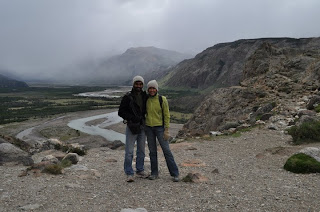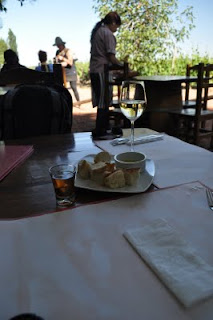Our introduction to Calafate had started 2 days ago, when we were waiting for the bus to Chalten. Neither of us had expected winds strong enough to practically knock us off our feet. Especially when we had our backpacks on. This was normal Calafate weather. Sunny, freezing, windy as hell.
There's the frontier-town look and feel (still there, albeit fully gentrified), the stark expanse of the plains and the freakish weather, but one thing draws everyone to Calafate and that's the glaciers. Or for most people, one Glacier. The Perito Moreno, at the far end of Lago Argentino. That's what we'd come to see too.
We parked ourselves at the Hostel de las Manos, who had sent someone with a board to advertise at the bus stop. We happily obliged. Warm and cozy, with a friendly little common kitchen, we got a shared 6-person dorm with a much-needed super clean, hot water shower! Of course, surprise surprise, J. (Iguazu, Bariloche, Calafate!) walked in to share the very same room.
The stories and tales one hears about the Perito Moreno are always going to be insufficient. Part of the Southern Patagonian Ice Field - the largest outside of the poles - the sight of it is imposing and there's no other word that I can describe it by. We took the ferry ride on the glacial lake, to the foot of the glacier. The freezing cold temperatures are little deterrent for the enjoyment of the glacier. The ice towers 50 meters above you and stretches 3 miles long with signs of glacial erosion strewn about everywhere. Along with views of the ice, you also see (and more often hear) massive chunks of it fall off into the lake - an absolutely stunning sight. The ferry took us up close to one side of the glacier, while the other side - which drains into the larger part of Lago Argentino and is cut off by an ice arch - was visible from an array of walkways and viewing galleries where we spent most of the day.
The rest of the charm of Calafate is in taking lazy walks and having long meals in a small, sleepy town. Which is exactly what we spend the next day doing, including visiting the a small bird park/sanctuary where flamingos are to be found in the marsh. Neighbouring the park is the shore of the lake where we stared at icebergs floating majestically by. Our day was rounded off by some humita and beer at a long lunch in town, with - of course - a stop off at a delightful local bakery for pastry and coffee. Another long haul bus ride awaited us, for the next stop: Puerto Madryn.
There's the frontier-town look and feel (still there, albeit fully gentrified), the stark expanse of the plains and the freakish weather, but one thing draws everyone to Calafate and that's the glaciers. Or for most people, one Glacier. The Perito Moreno, at the far end of Lago Argentino. That's what we'd come to see too.
We parked ourselves at the Hostel de las Manos, who had sent someone with a board to advertise at the bus stop. We happily obliged. Warm and cozy, with a friendly little common kitchen, we got a shared 6-person dorm with a much-needed super clean, hot water shower! Of course, surprise surprise, J. (Iguazu, Bariloche, Calafate!) walked in to share the very same room.
The stories and tales one hears about the Perito Moreno are always going to be insufficient. Part of the Southern Patagonian Ice Field - the largest outside of the poles - the sight of it is imposing and there's no other word that I can describe it by. We took the ferry ride on the glacial lake, to the foot of the glacier. The freezing cold temperatures are little deterrent for the enjoyment of the glacier. The ice towers 50 meters above you and stretches 3 miles long with signs of glacial erosion strewn about everywhere. Along with views of the ice, you also see (and more often hear) massive chunks of it fall off into the lake - an absolutely stunning sight. The ferry took us up close to one side of the glacier, while the other side - which drains into the larger part of Lago Argentino and is cut off by an ice arch - was visible from an array of walkways and viewing galleries where we spent most of the day.
The rest of the charm of Calafate is in taking lazy walks and having long meals in a small, sleepy town. Which is exactly what we spend the next day doing, including visiting the a small bird park/sanctuary where flamingos are to be found in the marsh. Neighbouring the park is the shore of the lake where we stared at icebergs floating majestically by. Our day was rounded off by some humita and beer at a long lunch in town, with - of course - a stop off at a delightful local bakery for pastry and coffee. Another long haul bus ride awaited us, for the next stop: Puerto Madryn.





























 A sleepy, little town, Neuquen has little to do except visit the dig sites and museums around it where lie a plethora of fossils. Thanks to rich sedimentary rock formations at the site of a water body which receded, there are enough fossils for you to practically crunch underfoot. Neuquen's moment in the sun arrived when the bones of largest carnivorous dinosaur (the aptly and imaginatively named Gigantosaurus Carolinii) were discovered here.
A sleepy, little town, Neuquen has little to do except visit the dig sites and museums around it where lie a plethora of fossils. Thanks to rich sedimentary rock formations at the site of a water body which receded, there are enough fossils for you to practically crunch underfoot. Neuquen's moment in the sun arrived when the bones of largest carnivorous dinosaur (the aptly and imaginatively named Gigantosaurus Carolinii) were discovered here.









 We arrived in Mendoza in the morning, after an overnight bus from Cordoba. Based on Lonely Planet's recommendation, we took a taxi to a hostel called Damajuana, but found it to be above our budget for the day, although it was a lovely place! We walked along till we found a hostel we could afford, although it was considerably less lovely (Hostel Itaka). The only saving grace was our first view of the lower Andes from our window!
We arrived in Mendoza in the morning, after an overnight bus from Cordoba. Based on Lonely Planet's recommendation, we took a taxi to a hostel called Damajuana, but found it to be above our budget for the day, although it was a lovely place! We walked along till we found a hostel we could afford, although it was considerably less lovely (Hostel Itaka). The only saving grace was our first view of the lower Andes from our window!



